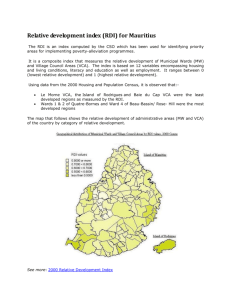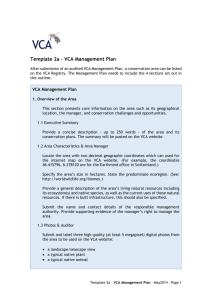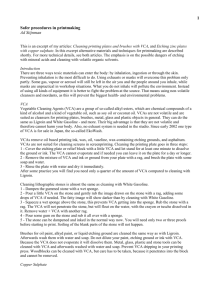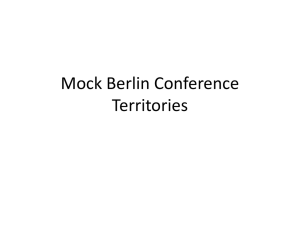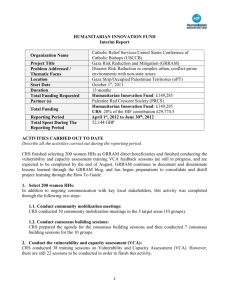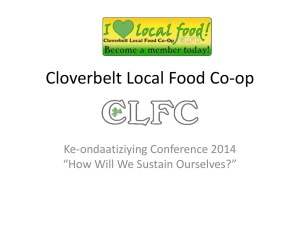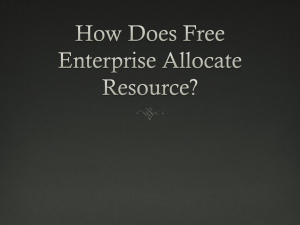Value Chain Analysis Training
advertisement
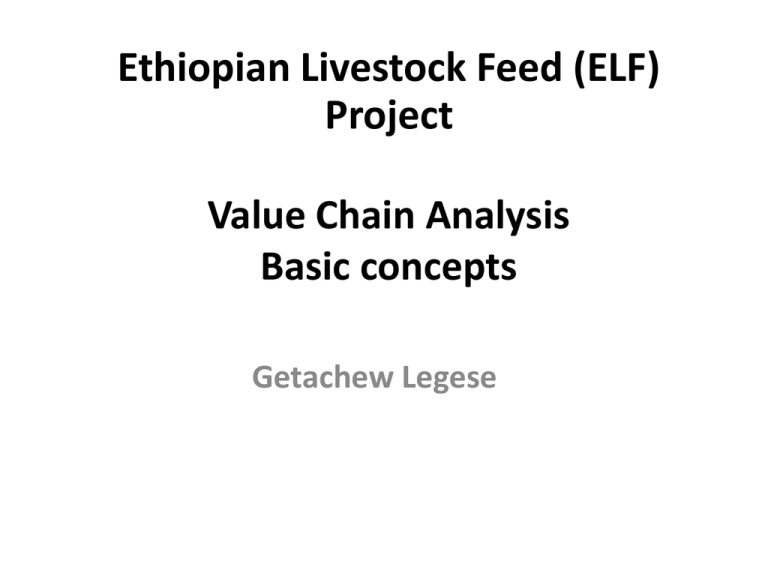
Ethiopian Livestock Feed (ELF) Project Value Chain Analysis Basic concepts Getachew Legese Presentation outlines • Basic concepts in Value Chain Analysis – – – – – – Value and value addition Value Chain agricultural value chain Stages of a value chain Business development services Value chain leader • Why the interest on value chain analysis (VCA)? • Potential objectives of VCA • How to conduct VCA – – – – – Data collection Value chain mapping Analysis of constraints and opportunities Value Chain frame work Validating findings of VCA Basic concepts of Value Chain Analysis Value and value addition Value – Amount a good or service is worth of in the market – Three types of value • Form value – associated with the change of the form of a raw material (production, processing) • Time value - related with availing at another period of time produce produced at a period of time (storage) • Space value - related with availing at another location product produced in one location (transport) What is a Value Chain (1) • VC encompass the full range of activities and services required to bring a product or service from its conception to sale in its final markets. • VC includes input suppliers, producers, processors and buyers. • They are supported by a range of technical, business and financial service providers What is a Value Chain (2) • A value chain entails the addition of value as the product progresses from input supply to production to consumption. • Value chains are also the conduits through which: – finance (revenues, credit, and working capital) moves from consumers to producers; – technologies are disseminated among producers, traders, processors and transporters; – information on customer demand preferences are transmitted from consumers to producers and processors and other service providers. What is an agricultural value chain? • An agricultural value chain is considered as an economic unit of analysis of a particular commodity (eg. milk) or group of related commodities (eg. dairy) that encompasses a meaningful grouping of economic activities that are linked vertically by market relationships. • The emphasis is on the relationship between networks of input suppliers, producers, traders, processors, and distributors. Stages of a value chain • Any operating stage capable of producing a saleable product or service serving as an input to the next stage in the chain or for final consumption or use • A stage of production in a value chain performs a function that makes significant contribution to the effective operation of the value chain • Typical value chain linkages include input supply, production, assembly, transport, storage, processing, wholesaling, retailing, and utilization, with exportation included as a major stage for products destined for international markets. Business development services • Services that play supporting role to enhance the operation of the different stages in the value chain and the chain as a whole – Infrastructural services (market place development, roads and transportation, communication, energy supply, water supply) – Production and storage services (input supply, genetic and production hardware from research, farm machinery services and supply, extension services, weather forecast, storage infrastructure) – Marketing and business skills (market information, market intelligence, technical and business training, facilitation of linkages of producers with buyers, organization and support for collective marketing) – Financial services (credit, saving, risk insurance) – Policy and regulatory services (property rights, market and trade regulations, investment incentives, legal services, taxation) The Value Chain and Business support services Consumption Retailing Trading Research Processing Transportation Trading Govt. policy regulation Transport Post-harvest handling Production Input Suply Communications Production input supply Tech. & business training & assistance Financial services Market information and intelligence Value chain leader • An organization with major stake in the value chain and plays crucial role in the functioning, performance and development of the value chain. • Value chain leaders are especially critical in the development of new and emerging value chains • Value chain leader could be private business which intends to make profit or a public agency which intends to promote the development of the value chain. Why the interest on value chain analysis (VCA)? • A comprehensive understanding of the operation of commodity markets requires an understanding of the operation of the different stages through which a product and its associated value additions pass on from production to consumption or end use • A comprehensive understanding of the coordination of the value chain requires a careful assessment of consumer demand characteristics and the organizational and institutional arrangements that are in place to meet these demands. Potential objectives of VCA • Identification of leverage points to improve chain performance • Analysis of agriculture-industry linkages • Analysis of income distribution • Analysis of employment issues • Analysis of economic and social impacts of interventions • Analysis of environmental impact of interventions • Guide collective action for marketing • Guide research priority setting • Conduct policy inventory and analysis How to conduct a VCA Value chain analysis consists of a four step process: 1. Data collection and analysis, 2. Chain mapping (actors, functions and relationships) and end market analysis 3. Analysis of opportunities and constraints, and 4. Validating the findings of the VCA through stakeholders forum The process of VCA & its components Data collection (1) • Good value chain analysis begins with good data collection, from the initial desk research to the targeted interviews. • Both qualitative and quantitative data are required for the VCA. • The qualitative data are collected using PRA tools such as: focused group discussions, Key Informant interview, personal observations, etc Data collection (2) Tools to be used • Review of relevant literature: reports, documents, databases, and websites relevant for the study will be reviewed. • The aim is to familiarize the team with the industry, its market and the business environment in which it operates, as well as to identify sources for additional information. • Secondary data will be collected from CSA, CRA, woreda and zonal offices, and other relevant sources – price and marketing data, – number of different market actors in the specific rural markets, – credit provided, – technology supply and distribution, – storage and transport facilities, – information on processing, packaging and grading will be collected. Data collection (3) PRA tools to be used • Focused group discussions (FGD): a useful way to explore concepts, generate ideas, determine differences in opinion between stakeholder groups and triangulate with other data collection methods • FGD can better capture the social interaction and spontaneous thought processes that inform decision making, which is often lost in structured interviews. • At least two FGDs of farmers (10-15 people) per district will be conducted • In depth Key Informant Interview (KII): interview with knowledgeable individuals: experts of livestock extension, livestock marketing, forage production and marketing, cooperatives promotion, abattoir managers, traders, meat supermarket managers, butchers, feed and livestock researchers, transporters, veterinarians and NGOs will be held. Data collection (4) PRA tools to be used • The KII should inform: • value chain actors’ current capacity to learn; • how information is exchanged among participants; • from where they learn about new production techniques, new markets and market trends; • the extent of trust that exists among actors; and • identify where chain participants see opportunities for and constraints to upgrading. • Visits: marketing and processing facilities and transactions in market places will be visited in all the sites. At least one feed and livestock market per woreda will be visited. Processing facilities such as dairy processing plants, feed processors and export abattoirs will be visited. Data collection (5) • The qualitative data gathered by the above methods will reveal dynamic factors of the value chain such as: trends, incentives and relationships. • To complement this, quantitative analysis of the chain is necessary to provide a picture of the current situation in terms of: – the distribution of value-added, – profitability, – productivity, – production capacity and – benchmarking against competitors. • Analyzing these factors highlights inefficiencies and areas for reducing cost. Value Chain Mapping (1) • Value chain mapping is the process of developing a visual depiction of the basic structure of the value chain. • A value chain map illustrates the way the product flows from raw material to end markets and presents how the industry functions. • It is a compressed visual diagram of the data collected at different stages of the value chain analysis and supports the narrative description of the chain Value chain mapping(2) Objectives • To gain basic overview of the value chain to guide the full VCA to be undertaken • Identify constraints and possible solutions at different levels in the VC • Visualize networks to get a better understanding of connections between actor and processes • Demonstrate interdependency between actors and processes in the VC • Create awareness of actor to look beyond their own involvement in the VC Value Chain Mapping (3) A two phased process for developing the value chain mapping is recommended a) initial basic mapping based on the information derived from desk research and knowledge at the outset of the analysis, and b) adjusted mapping that includes revisions based on interviews and feedback from firms and individuals brought into the analysis process value chain mapping (3) • There is no such a thing as a comprehensive, all encompassing VC map • There are many potential dimensions of the VC that could be included in an initial mapping exercise: – The core processes in the VC – The main actors in the process – The product flows, – Volume of product flow – Costs and margins at different levels – Constraints and opportunities at the different levels – Flow of information etc • Therefore it is crucial to choose which dimensions are to be mapped based on the available resources, the scope and objective of the VCA and mandate of the organization. Mapping the core processes • The first question that must be asked in any value chain analysis is what the different processes in the value chain are. • Example: Core processes in sheep VC (SNNP & Oromia) Input Supply Production Trading Processing Domestic Consumption/ Export Mapping actors along the value chain Example: Actors along the core processes of the sheep value chain Input Supply • Sheep producers • The extension system Production Small holder farmers Trading • Collectors • Brokers • Small traders • Big traders • Sheep fatteners Processing • Export abattoirs • Shoat butchers • Super markets Consumption • Meat exporters • Live animal exporters • Individual consumers in big towns and Addis • Hotels and restaurants • Farmers (for fattening/rearing) Mapping activities along the VC Example: Core processes and activities in the sheep VC Input Supply • Breeding stock • Veterinary services • Feed • Water • Housing Production • Rearing • Fattening Trading • Collection • Transportation • Distribution to consumers(retail , wholesale) Processing • Slaughter • Chilling • Packing Domestic Consumption/ Export • Domestic consumption • Export to MENA countries Mapping product flows Example: Sheep value chain functions, actors, and product flows Consumption Export markets Processing Export abattoirs Live animal Trading Big traders Production Input Supply Hotels and restaurants Consumers in big tows and Addis Ababa Live animal exporter Small traders Shoat butchers Collectors Small holder farmers Business and Extension services Local consumers Super markets Brokers Farmers (breeding/ fattening) Mapping Volume of product flows Example: Product Supply Pattern in the Shoat Value Chain (Borena) Producers 23% 100% Collectors 77% 46% 60% 54% Small traders 12% 14% 6% Big traders 23% Purchasing agents 50% 22% Cooperatives 50% Live animal exporters 8% 63% 28% 61% Export abattoirs 3% Mapping the flow of values and benefits Example: Costs and margins of actors involved in a market channel selling shoats to supermarkets Small Producers Brokers Collectors traders Selling price Super markets 750 810 820 870 1280 Marketing cost - 0 16 39 95 Marketing margin - 60 70 50 410 Net margin Producer's share of final price (%) - 60 54 11 315 - - - - 59 Making a value chain map matrix • A VC map matrix is the matrix which summarizes the key information from maps in one table. • The matrix can be used as the basis for designing questionnaires, determining which actor groups to interview and which geographical locations to concentrate field work in. • It can also serve as an easy to interpret sector summary from VC perspective. Input supply Production Activities actors Inputs outputs locations challenges Possible solutions trading processing consumption Group Work • Map core processes, actors, activities, inputs, outputs, Challenges and possible solutions for the commodities for which VCA is conducted in your respective sites (Dairy, Beef and Sheep)
